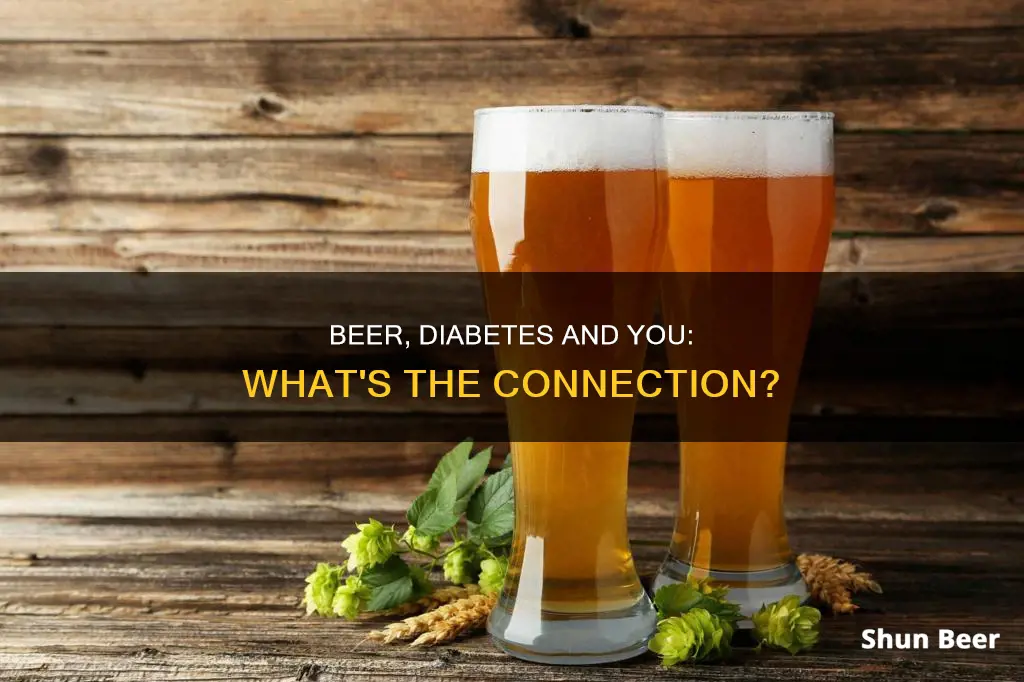
Drinking light beer will not directly cause diabetes, but it can affect blood sugar levels and influence the onset of the condition. Beer contains carbohydrates, with a 12-ounce beer containing about 15 grams of carbs, while light beers typically have 3 to 6 grams. Alcohol inhibits the liver's release of glucose, which can lead to low blood sugar. This effect is particularly important for people with diabetes, as they need to carefully manage their blood sugar levels. For those with type 2 diabetes, drinking alcohol may provide some benefits, such as slightly reducing glucose levels, but it also has risks, including increasing insulin resistance over time.
| Characteristics | Values |
|---|---|
| Can drinking light beer cause diabetes? | No evidence found to support this. |
| Carbohydrates in light beer | 3-6 grams per serving |
| Alcohol content in light beer | 4-7% |
| Recommended alcohol consumption for people with diabetes | No more than one drink per day for women and no more than two drinks per day for men |
| Alcohol's effect on blood sugar | Alcohol inhibits the release of glucose from the liver, causing low blood sugar. |
| How to drink alcohol safely with diabetes | Drink in moderation, choose low-sugar and low-carb beverages, don't drink on an empty stomach, and monitor blood sugar levels |
What You'll Learn

Light beer contains fewer carbs than regular beer
Light beer typically contains fewer carbs than regular beer. Beers usually have 2-12% ABV (alcohol by volume), and those with lower ABVs tend to have fewer carbs. For example, a beer with an ABV of 7% or less will likely have around 6 grams of carbs, whereas a beer with a higher ABV may have 20-30 grams of carbs per 12-ounce bottle.
Light beers usually have 5 grams or fewer of carbs per serving. For instance, Budweiser Select 55 has 1.9 grams of carbs per serving, while Corona Premier has 2.6 grams. Michelob Ultra Pure Gold has 2.5 grams of carbs per 12-ounce bottle, and Amstel Light has 5 grams. Beck's Premier Light is another option, with 3.9 grams of carbs and a low ABV of 2.3%.
When it comes to beer, one drink is typically considered to be 12 ounces. The American Diabetes Association (ADA) recommends no more than one drink per day for women and up to two drinks per day for men. It is important to note that the definition of "light" beer can vary among brands, and it may refer to lower alcohol content, fewer calories, or both. Additionally, drinking light beer in larger quantities than regular beer may not significantly reduce weight gain, as light beer is only lower in calories when compared to the same brewery's leading variety of regular beer.
Swift's Beverage Choice: Beer or Bubbly?
You may want to see also

Alcohol competes with the liver's ability to make glucose
Alcohol can affect the liver's ability to regulate blood sugar levels. The liver is responsible for detoxifying the body of alcohol, and when it is busy breaking down alcohol, it may not release enough glucose to keep blood sugar levels high. This can be particularly significant for people who take insulin or medications that increase insulin production, as the liver may not be able to release enough glucose to counteract the insulin in the body. This can lead to hypoglycemia, or low blood sugar. The effects of alcohol on the liver can last for several hours after drinking, so it is important to monitor blood sugar levels during and after drinking alcohol.
People with diabetes are at an increased risk of hypoglycemia when drinking alcohol, especially if they drink on an empty stomach or when blood sugar levels are already low. Alcohol can also interact with certain medications, such as insulin, to further increase the risk of hypoglycemia. It is important for people with diabetes to work with their doctor to determine if it is safe to drink alcohol and to learn how to prevent and treat hypoglycemia.
Additionally, alcohol can mask some of the warning signs of hypoglycemia, making it more difficult to recognize and treat low blood sugar levels. This can be dangerous, especially when combined with activities such as driving or operating machinery. It is important to be aware of the risks and take precautions when drinking alcohol, such as not drinking on an empty stomach, drinking in moderation, and regularly monitoring blood sugar levels.
The Science of Beer: Foam Detectors Explained
You may want to see also

Drinking on an empty stomach can cause hypoglycaemia
Drinking on an empty stomach can therefore cause hypoglycaemia, especially in people with diabetes. This is because their liver may not be able to produce enough glycogen to prevent blood sugar levels from falling too low. The risk is even higher for those who go to bed without taking additional carbohydrates, as hypoglycaemia can occur overnight.
To prevent hypoglycaemia, it is recommended that you do not drink on an empty stomach and that you eat a meal with protein, fibre, and healthy fats before drinking alcohol. This will ensure that the alcohol is absorbed more slowly, keeping blood sugar levels stable. It is also important to monitor your blood sugar levels before, during, and up to 24 hours after drinking alcohol, especially if you have diabetes.
If you are drinking beer, it is recommended that you choose "light" beers, as these are lower in carbs, calories, and alcohol content. It is also important to pace yourself, drinking no more than one drink per hour and no more than three or four drinks in a day.
Beer and Urine: Is Pale Pee Beer-Related?
You may want to see also

Alcohol can increase the risk of hyperglycaemia
The liver plays a crucial role in maintaining healthy blood sugar levels by storing and producing glucose. When we consume alcohol, the liver prioritises breaking it down, which may result in the release of insufficient glucose, leading to hyperglycaemia. This effect is more pronounced when drinking on an empty stomach or when blood sugar levels are already low. Consuming alcohol with a meal can help slow down the absorption of alcohol, thus reducing the risk of hyperglycaemia.
For people with diabetes, it is essential to monitor blood sugar levels before, during, and up to 24 hours after drinking alcohol. Alcohol can also interact with certain medications, including insulin and insulin-stimulating drugs, further increasing the risk of hyperglycaemia. It is crucial for individuals with diabetes to consult their healthcare provider for advice on managing blood sugar levels when consuming alcohol.
Additionally, alcohol consumption can worsen diabetes-related complications, such as disturbances in fat metabolism, nerve damage, and eye disease. It can also lead to the accumulation of certain acids in the blood, resulting in severe health consequences. Therefore, it is important for people with diabetes to carefully manage their alcohol intake and follow the recommended guidelines for alcohol consumption.
Beer and Liquor Mixing: Safe or Not?
You may want to see also

Drinking in moderation can have health benefits
- Improved cardiovascular health: Numerous studies have found an inverse association between light to moderate drinking and the risk of heart attack, stroke, and other cardiovascular issues. This benefit is likely due to the impact of alcohol on "good" cholesterol (HDL) levels and other beneficial changes, such as improved insulin sensitivity and better blood clotting factors.
- Protection against type 2 diabetes: Moderate drinking may offer protection against type 2 diabetes. This effect has been observed in several studies, and it is believed to be related to the impact of alcohol on insulin levels and blood sugar regulation.
- Reduced risk of gallstones: In addition to its potential benefits for cardiovascular health, moderate drinking may also reduce the risk of gallstones. This benefit has been observed in studies such as the Nurses' Health Study and the Health Professionals Follow-up Study.
- Mood-boosting effects: Research suggests that moderate drinking can reduce stress, tension, and self-consciousness, while increasing feelings of happiness and euphoria. Additionally, a 2020 study found that moderate drinking was associated with a lower risk of depression in middle-aged and older adults.
- Stronger bones: Beer drinkers may experience increased bone density due to the silicon content in beer. Silicon is essential for bone mineral density, and moderate beer consumption has been linked to improved bone health, especially in women with osteoporosis.
It is important to note that these health benefits are associated with moderate drinking, and excessive alcohol consumption can have severe negative consequences for health. Additionally, drinking alcohol is not recommended for everyone, and individuals should consider their personal health and family history when making decisions about alcohol consumption.
Non-Alcoholic Beer and Minors: What's the Verdict?
You may want to see also
Frequently asked questions
Drinking light beer will not directly cause diabetes, but it can increase your risk of developing the condition. Regular, long-term alcohol use can lead to weight gain and increase insulin resistance, which are both contributing factors to type 2 diabetes.
Light beer contains fewer carbohydrates than regular beer, with 3-6 grams of carbs per serving compared to 10-15 grams in non-light beer. This means that drinking light beer is less likely to cause a spike in blood sugar levels. However, alcohol inhibits the release of glucose from the liver, which can lead to low blood sugar (hypoglycemia).
If you have diabetes, it is important to drink in moderation and follow the recommended guidelines: no more than one drink per day for women and up to two drinks per day for men. Always drink light beer with a meal to slow down the absorption of alcohol and prevent blood sugar spikes. Check your blood sugar levels frequently before, during, and up to 24 hours after drinking.
Light beer has a lower alcohol content and fewer carbohydrates than regular beer, so it can be a better option for people with diabetes. However, there is no definitive evidence that drinking light beer provides any specific benefits for diabetes management. The risks of drinking alcohol, such as hypoglycemia and increased insulin resistance, may outweigh any potential benefits.







